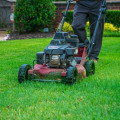A good lawn care schedule is essential for maintaining a healthy and vibrant lawn. Depending on factors like climate and grass type, it typically includes regular tasks such as mowing, fertilizing, watering, and aerating. In regions where properties may require small excavation services, proper lawn care is crucial to ensure a lush and thriving landscape. Specific timing and frequency may vary, but consistency is key. Consulting local experts can help you tailor a lawn care schedule that suits your unique needs, ensuring that your lawn remains in top condition throughout the year.
Lawn maintenance and fertilization does not end in summer. For cold-season grasses, fertilize twice in autumn to take advantage of excellent growing conditions. Fertilize once around early September and then once more 6 to 8 weeks later. For warm-season grasses, fertilize only once.
At the beginning of the month, clean the property with leaf blowers, vacuum cleaners and chippers. Later in the month before the grass starts to grow, use an electric rake to remove straw buildup from the previous year. Excess straw prevents water and nutrients from reaching the soil and may contribute to turf disease. Then use a planter to re-seed any thin spots that may appear or have been lost in the fall.
For northern grasses, mixtures of blue grass, fescue and rye are the most common. Apply Crab Lawn Protector before April 15 and start a lawn mowing regimen shortly after. A cutting height of between 2 and 3 inches is recommended to retain water, discourage weeds and promote deeper roots. At this time, spring aeration begins if the patio is heavily compacted.
Aeration improves root depth as well as airflow, water, fertilizers and nutrients. Feel free to leave the plugs on the lawn, as they will be mulched again after a few rains and cuttings. However, if you want to pick them up, wait a day or two for them to dry and rake or vacuum them. It is recommended to water the lawn the night before to soften the soil and allow the core depths to be 3. Each task has a time estimate and an effort rating on a scale of 1 (simple, a child could do it) to 4 (experience recommended).
Then, you can use one of the strategies explained below to create a routine that allows you to enjoy both your weekends and your beautiful garden. After sowing, fertilizing is the most important thing you can do to achieve a lush lawn. Fertilize once or twice in early spring and again in autumn. Divide your garden into sections and then fertilize one section each week until you have fertilized the entire yard.
During the summer, add mineral supplements if the color of the grass fades or turns yellow. Mowing the lawn without borders is like combing your hair but forgetting to shave. Misaligned grass edges make even the healthiest lawn look unkempt. Invest in a good edge trimmer and use it weekly to give the perfect finishing touch to your hard work.
Properly watered and fertilized lawns, and regular maintenance, will eliminate most weed problems; early prevention will do the rest, 5 An initial application of herbicide in early spring and spot treatments needed during the summer will keep your lawn weed-free. To save time, use a combined fertilizer and weed control product. Complete lawn maintenance before the weekend by combining tasks on weekdays. If you travel frequently, need flexibility or if your weekends are often packed with activities, this strategy is for you.
Free Weekend Routine Example Combine a time-consuming task with a faster task, or combine a high-effort task with a low-effort task. Assign task pairs to specific days of the week. During spring, mow twice a week. Complete a task each day of the week, leaving only one task for the weekend.
If you don't have big blocks of free time, this routine will work best for you. Complete a task each day of the week; pin tasks that require a lot of time and effort to those days when you have the most time and flexibility. During the spring, plan to re-mow the lawn on the 5th, before repairing the damage. Now that lawn maintenance has become a manageable science, you can relax and enjoy your weekends.
And if you see your neighbors sweating on Saturday and Sunday afternoons in their yards, don't rub it. You can do this by manually removing weeds or by using selective herbicides (also known as weeds and feed). If you are using herbicides, be sure to wait at least 3 weeks between applications. Read our guide on how to remove weeds here.
If you have oversown, you must wait at least 50 days before doing this step. Don't make lawn care confusing and difficult. Whenever you do monthly lawn maintenance, always remember these 6 steps. During winter and fall, you will need to adjust the cutting height to 3 inches.
For spring and summer, you can increase it to 4 inches. Manually remove weeds or apply weed control during the last week of spring. You can also get rid of weeds during the first two weeks of summer. Using a soil test kit helps you determine the right fertilizer for your lawn.
You can find soil test kits at your local garden stores. Perform a soil test only during spring and summer. To keep your lawn green, healthy, and growing, supply at least 1 inch of water per week, either by watering or raining. Watering time for the first hours of the morning (between 6 and 10 am, m.
Lawn needs about an inch of water every week, whether it's rain or sprinkler. Deep, infrequent watering is better than short, frequent sprinkler applications that promote shallow root growth. Deep watering will promote longer, stronger roots that can go further underground to get water. This is important in the summer heat and sun.
If your lawn receives less than an inch of water per week, the lawn may become inactive. It may not be the most pleasant time to work in the garden, but it must be done if you really want to follow the best lawn care program. We've taken the advice of the experts and reduced it to a simple lawn care plan that's easy to follow and doesn't cost the world anything. As the seasons change, lawn care in New Jersey also has to change to keep up with the different weather and weather conditions that place stress on lawns and plants.
To keep your lawn looking its best throughout the year, follow the advice in this seasonal calendar to ensure your lawn stays green and healthy. With lawn care in New Jersey, where winters are very cold, fertilization in fall protects cold-season grasses that sit dormant in winter. TruGreen takes care of the main tasks of keeping your lawn healthy, from aeration and fertilization to weed control and worm control. You should test the soil on your lawn to see what nutrients your lawn needs and therefore choose a fertilizer to apply.
After a long winter and a damp spring, waterlogged properties begin to dry out and property managers begin the annual ritual of preparing the lawn and thinking about lawn maintenance programs for the next few days outdoors. Weekly lawn mowing, regular weeding, pruning and trimming are the best ways to maintain a well-maintained lawn. If debris remains on the lawn during cold weather, especially in case of snow, they can create large dead spots on the lawn. Whether you're just starting out, servicing or troubleshooting, you'll find tips and answers for all your lawn care needs here.
This is the time of year when lawn care becomes crucial to starting healthy growth and strong root systems after a long, cold winter. Lawn care companies offer annual programs that can take care of all the tasks you may need, from fertilization to aeration, soil amendment, and worm control. When spring is in full swing, lawn maintenance is essential to keeping lawns and landscaping well-kept. Ask your gardening provider about lawn care in New Jersey that provides additional herbicide treatment after the emergency if weeds are getting out of control.






